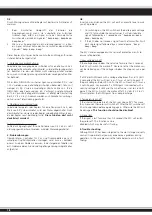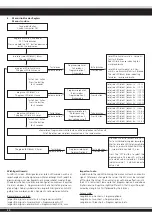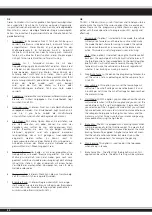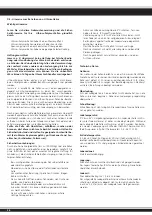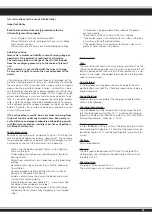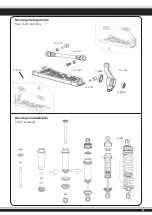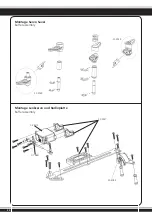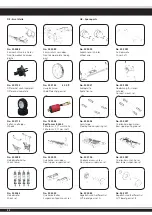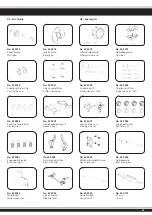
18
DE
Durch Warnsignale macht der Regler auf bestimmte Zustände auf-
merksam:
1. Beim
Einschalten
überprüft
der
Prozessor
die
Eingangsspannung, wenn sie außerhalb der zulässigen
Grenzen liegt, ertönt ein Signal mit einer Sekunde Pause,
zwischen den einzelnen Signalen “beep-beep-, beep-beep-,
beep-beep-”
2. Wenn das Eingangssignal nicht ordnungsgemäß ist, ertönt
ein Signal mit zwei Sekunden Pause, zwischen den einzelnen
Signalen “beep-, beep-, beep-”
Dieser Regler ist mit einer Reihe von Schutzeinrichtungen für einen
sicheren Betrieb ausgestattet:
1. Unterspannungsabschaltung:
Sobald die Spannungslage eines LiPo-Akkus für eine Zeit von 2 Sek.
die eingestellte Schwelle unterschreitet, wird der Motor abgeschal-
tet. Beachten Sie, dass der Motor nicht wieder gestartet werden
kann, wenn sich die Spannung unterhalb des voreingestellten Wer-
tes befindet.
NiCd- bzw. NiMH-Akkus mit einer Spannung zwischen 9,0 V und
12,0 V werden wie ein dreizelliger LiPo-Akku behandelt, Akkus mit
weniger als 9,0 V wie ein zweizelliger LiPo-Pack. Wenn z. B. ein
NiMH-Akku eine Spannung von 8,0 V aufweist, und die Schwelle
auf 2,6 V pro LiPo-Zelle gesetzt worden ist, erfolgt die Abschaltung
bei 5,2 V (2 x 2,6 V). Dadurch werden auch Nickelzellen wirkungs-
voll vor einer Tiefentladung geschützt.
2. Übertemperaturabschaltung
Sobald die Temperatur des Reglers, für eine Dauer von 5 Sek., den
Wert von 95°C überschreitet, wird der Motor abgeschaltet. Nach
dem Abschalten müssen Sie den Regler unbedingt abkühlen lassen,
da der Regler sonst beschädigt wird.
Diese Funkton darf nicht
deaktiviert werden!
3. Fehlerhaftes Eingangssignal
Sollte das Eingangssignal für eine Zeitdauer von 0,2 Sek. als nicht
ordnungsgemäß erkannt werden, wird der Motor abgeschaltet.
5. Problemlösungen
Obwohl dieser Controller für Car- und Truckmodelle einer auf-
wändigen Qualitätskontrolle unterzogen wird, kann es trotzdem
einmal zu einem Problem kommen. In der folgenden Tabelle sind
evtl. Probleme deren Grund und zugehörige Lösungsmöglichkeiten
aufgelistet.
GB
In certain circumstances the ESC will omit an acoustic tone to warn
you of a problem:
1. On switching on, the ESC will check the battery pack voltage
and if it falls outside the correct values it will omit double
signals followed by a 1 second pause: “beep-beep-, beep-
beep-, beep-beep-”
2. If the ESC does not receive a signal from the transmitter it will
omit single signal followed by a 2 second pause: “beep-,
beep-, beep-”
The ESC has ben equipped with a series of protective circuits to
ensure safe operation:
1. Low voltage cut-off:
If the voltage drops below the set value for more than 2 seconds
the ESC will switch the motor off. Please note that the motor can-
not be started again if the voltage is below the choosen value per
cell.
If a NiCd or NiMH pack with a voltage of between 9 and 12 Volts
is connected, the ESC will treat is as if it was a 3 cell LiPo pack. If
the pack voltage is below 9.0 Volts, the ESC will react as if it was a
2 cell LiPo pack. For example, if a NiMH pack is connected with a
nominal voltage of 8 Volts and the cut-off value is set to 2.6 Volts
per cell, the ESC will switch the motor off at 5.2 Volts (2 X 2.6 V).
This will protect the NiMH packs from ‘deep discharge’.
2. Temperature cut-off
If the internal temperature of the ESC rises above 95°C for more
than 5 seconds the motor will switch off. After the ESC switches off
it has to cool down before operating again. Otherwise the ESC will
be damaged.
This function should not be disabled!
3. Signal loss
If the signal is lost for more than 0.2 seconds the ESC will switch
the motor off. This function can be
disabled which may be useful if racing.
5. Trouble shooting
Although this ESC has been subjected to the most stringent quality
control it is possible that you may experience a problem during
operation. In this case please use the table below to assist in fault
finding.
Summary of Contents for 05 3260
Page 31: ...31 50 5126 22 Z T 50 5026 13 0046 Montage Motor Motor assembly...
Page 38: ...38...
Page 39: ...39...















